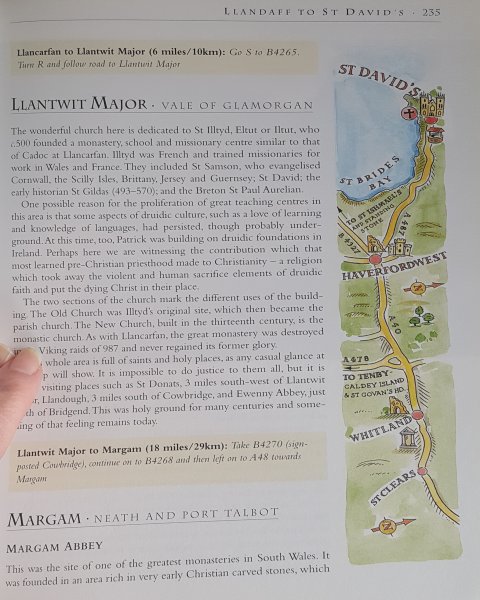
OK let’s start off by saying this book is a little odd and although I’m sure it could be used in the way it appears to have designed I have never done so in the twenty four years I have owned it. The book lives in my car rather than on a bookshelf and the times I have referred to it are when I am away from home and for some reason have some spare time to do a little exploring. But lets get back to why I think it’s odd. Firstly it is sponsored by the World Wildlife Fund for Nature. Now why, coming up to the millennium, this charity thought it appropriate to involve itself in a project regarding sacred spaces is beyond me as apart a small reference to trees and plants commonly found in a British churchyard there appears to be nothing linking nature to this book. Secondly although there are ancient pilgrimage routes in Britain these have been largely ignored by the authors, apart from one route to Canterbury cathedral, and instead they have created their own routes linking various sites which are usually associated with a varied selection of faiths, including pagan, all in one journey. Even the journey to Canterbury which was a major Christian pilgrimage in medieval times especially for those unable for financial or time reasons to make the trip to the Holy Land the suggested journey in this book goes via an iron age fort, the remains of a 1000 year old synagogue, a druids grove and some neolithic burial mounds, none of which fit in with a Christian pilgrimage. The inclusion of some excellent churches, cathedrals and ruined abbeys does not really get away from the trip being an odd mish mash of sites. The third oddity is to do with the panel maps within the text of the routes which are all narrow vertical pictures regardless of the true geography and to my mind are also upside down. Now there are ‘proper’ maps as well but these are the ones that you have to hand so to speak.

The example above shows what I mean, this is a journey TO St David’s and if you are going to ignore geographic orientation, north is to the right on this panel, then at least work down the picture to the destination not up. Also as you can see the text doesn’t actually refer to the map on the page, in fact that part of the journey is eight or nine pages further on, where there is no map but could easily have been one. The whole page layout throughout the book is as confusing as the selection of routes, you find yourself either inserting lots of bookmarks or constantly flipping between pages in an attempt to follow what is going on.
So why am I reading it this time, rather than dipping in for a specific locality which is my usual way of using the book? Well England is about to come out of what is the third and hopefully last lock down to prevent the spread of Covid 19 and I’m desperate to escape these four walls and go somewhere, in fact pretty well anywhere and I’m looking for inspiration. In all there are thirteen of these suggested journeys and they cover most of England, Scotland and Wales, the latter two will still be out of bounds next week but it should be possible to go somewhere in England if only for a day trip as overnight accommodation is still not easily available and won’t be for at least another month, probably longer. I’m not looking for a route but a destination preferably not too far away and if there is somewhere else interesting near to it then that would be a bonus. The one advantage of the route structure of the book is that places near one another are next to each other in the book so you can get happy accidents of two or three interesting places all in one go.
There are also sections that don’t stick to the routes but dot around by theme and one of these chapters on stone circles and tombs has probably inspired me to journey out on day trips more than any other and this is the only travel guide I own that specifically has a section on these ancient sites. So what to make of the book as a whole, well as I said at the beginning it’s odd and doesn’t really work in the way it was intended. It can also be infuriating due to the constant chopping and changing of pages to see what should be all together but it has earned its place in my car for when I have a spontaneous urge to go somewhere unplanned. It also has the advantage that it doesn’t matter that it is nearly a quarter of century old, which would be a serious handicap in most guide books as it is specifically pointing you to places that largely haven’t changed for centuries and will remain for years to come.
This book was originally published in 1997 by Piatkus in the UK and was reprinted in the USA in 2000 by Hidden Spring Books under the title ‘The Spiritual Traveller’. The sequence of some of the chapters are altered and suggestions of places to stay are added in the American edition but the books are to all intents and purposes the same.

How varied is your collection of Penguin books? What value would you place on a Allen Lane Christmas book The Rime of the Ancient Mariner in good condition?
LikeLike
In good condition that sells for about £200 but the main thing to look out for is that the blue leather fades very easily, especially on the spine, and that probably determines the price. My collection of Penguin books runs to around 3,500 first editions.
LikeLike